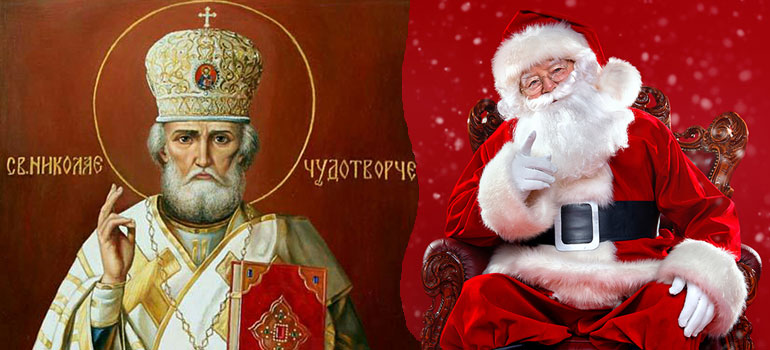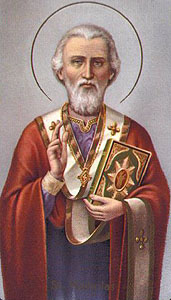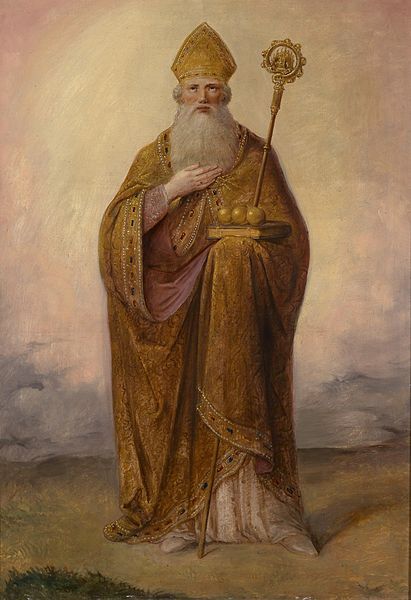
Today, Saint Nicholas known almost to everybody as Santa Claus, is a nice old man, necessarily with a long beard and rounded belly, in a red outfit and a hat with a pompom. He lives in Lapland or at the North Pole. And do you know who Saint Nicholas was? Here is a short story that is worth teaching to your children.
Nowadays, nice old man, essentially with a long beard and rounded belly, in a red outfit and a hat with a pompom. He lives in Lapland or at the North Pole. During the Christmas season, he delivers gifts to children in a sleigh pulled by a reindeer cart. The figure of Nicholas makes children smile and gives them a lot of joy while waiting for the birth of Jesus. And do you know who Mikołaj was? Here is a short story that is worth introducing to children on St. Nicholas’ Day.
The real story of the Bishop of Myra
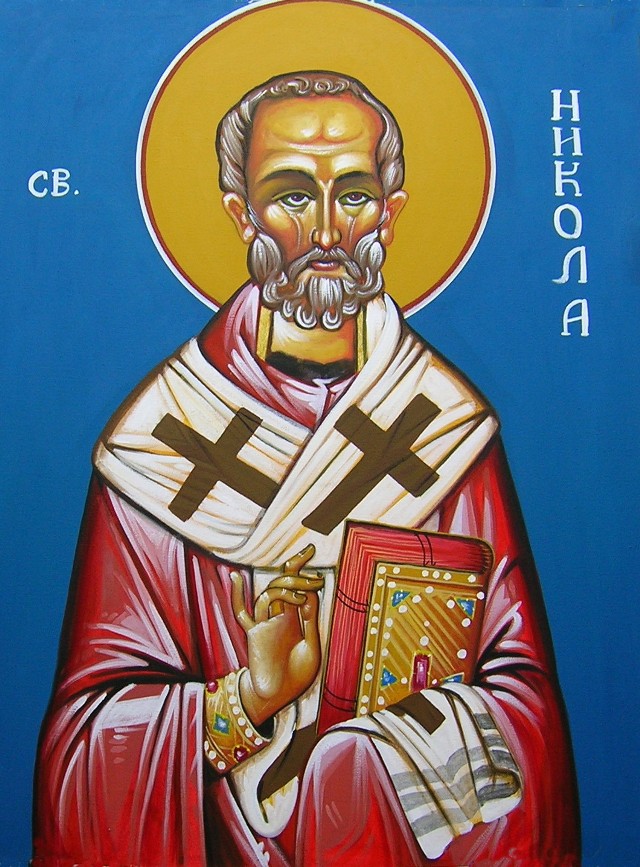
The name Nicholas comes from Greek and consists of two parts: Nike – “to win” and Laos – “people” Saint Nicholas, bishop of Myra in Lycia, due to the deeds attributed to him by legend, was the prototype of the figure giving gifts to children. Yes, the beloved all over the world Santa Claus.
Everything happened in the 3rd and 4th centuries AD in today’s Turkey (former Patara).
Before he was actually canonized a saint, Saint Nicholas was Bishop of Myra in Lycia (today’s Turkey). He lived at the turn of the 3rd and 4th centuries AD. The boy prayed by his parents became a miracle for them. As an adult man, he gained fame for his good deeds.
He died on December 6. In memory of this day, St. Nicholas’ Day is now being celebrated. His relics are in the Italian city of Bari. He is the patron of many places and professions, many temples in the world are dedicated to him. However, Mira’s bishop did not wear a hat with a pompom and did not walk around with a sack full of toys. In paintings and icons, he is depicted as a slim man dressed in a red bishop’s robe, with a miter on his head, a crosier in one hand and / or a book in the other hand.
Nicholas inherited the property from his parents. He was the only child. He could live in luxury, but he preferred to help the poor and needy and it was them who gave away his wealth. What gifts did his children give him? Most often they were given bread, nuts, money for sweets and books, crosses, holy pictures, tablets, caged birds, or … a rod. He was a good, pious and merciful man, which is why the inhabitants of Mira chose him as their bishop.
Fables and legends sing about the fame and glory of Nicholas, describing his good deeds. He became famous as a miracle worker, saving sailors and the city from starvation. He showed courage and justice by saving the unjustly convicted imperial officials from death. He died in old age, on December 6 in the middle of the 4th century AD (between the years 345 and 352). His relics have been in the Italian city of Bari since the 11th century to the present day. The figure of Mikołaj is one of the most colorful hagiographic figures.
What are the attributes of the Bishop of Mira? An angel with a miter, bread, three golden balls on a book, three apples, three pouches, three children or young men in a knot, an anchor, a ship, a crosier, and a sack of gifts. In paintings, e.g. in churches, Nicholas usually appears in the company of Jesus and Mary.
The cult of Nicholas
Throughout the Christian world, St. Nicholas had so many temples that a medieval writer writes:
“If I had a thousand mouths and a thousand tongues, I would not be able to number all the churches built in his honor”.
In the 13th century, it was customary to distribute in schools under the patronage of St. Nicholas on scholarships and allowances. From at least the 15th century, it was customary to build “St. Nicholas”, in which the Saint was supposed to present gifts. Over time, boats were replaced by shoes and socks, or – in Protestant regions – Advent gift plates. The figure of St. Nicholas was immortalized by many painters and sculptors. The oldest image of St. Nicholas (6th century) can be seen in one of the Beirut churches. In Poland, there are currently over 300 churches and cathedrals dedicated to St. Nicholas of Myra (the most impressive are the churches in Gdańsk and Elblag and the cathedrals in Elblag, Kalisz, and Bielsko-Biala). The first chapel dedicated to him was built there in the 14th century. The miraculous figure of St. Nicholas, where the faithful have been asking for favors of health for themselves and their loved ones for years.
In the 11th century, when Mira was conquered and completely looted by Muslims, the relics of St. Nicholas were moved to Bari and it is this city that today all pilgrimages want to visit the tomb of St. Nicholas. While there is very little real information about Mikołaj, a lot of legends and myths related to the person of the saint have arisen. Mikołaj was always presented as a mysterious person, extremely good and helping all people. Even as a child, Mikołaj distinguished himself by his piety and kindness towards his fellow men. As an adult, Nicholas shared his wealth with all those in need, and he did not give up helping others even when he was already appointed bishop. He gave alms with a generous hand, and at night he left pouches of money in front of the houses of the poor. One of the stories about the generosity of Nicholas is the story of the three daughters of a very poor inhabitant of Lycia, who could not provide any dowry for the children. Thanks to Nicholas’s help, all three daughters got married happily. Thanks to his good deeds, St. Nicholas received the gift of working miracles from God.
For example, he was able to save shipwrecked people from the waves, made crops grow in times of crop failure, and even raised the dead. People quickly called him the miracle worker, and the followers of the Orthodox religion still describe St. Nicholas. Stories about the miraculous deeds of St. Nicholas were passed down from generation to generation. Nicholas became the patron of shipwrecked people, sailors, fishermen, raftsmen, and carriers, he had the power to tame storms, high waves, lightning, and storms. With his protection, St. Nicholas j also surrounded prisoners and prisoners of war, his help was asked by monks, scholars, writers, notaries, students before exams, millers, and brewers. Mikołaj also looks after the virtuous virgins on the issue. In the 18th century, boxes of St. Nicholas, and thanks to donations thrown into boxes, dowries were funded for the poorest girls from a given parish. In the Polish folk tradition of St. Nicholas also became the patron saint of cattle and animal shepherds, which he protected from attacks by wolves. At the same time, St. Nicholas also cares for wolves so that they do not die of cold and hunger during the harsh winter. On December 6, on the day of St. Nicholas, the hosts and shepherds prayed to the saint, kept fast, and in the evenings lit fires and made sacrifices called wolves – these were flax and hemp wreaths, which were hung on the altars and covered with eggs. As people in the villages believed, St. Nicholas was so good that he even looked after mice and rats.
Santa Claus from Coca Cola Commercial
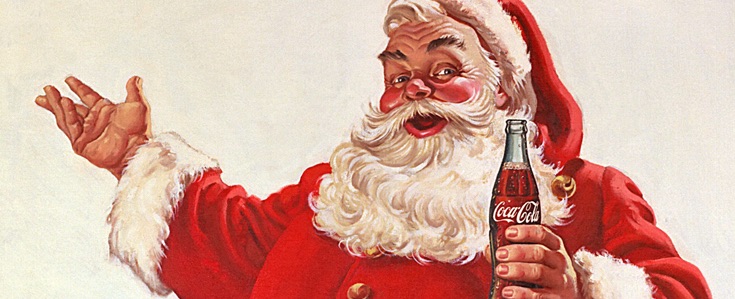
When is it time to start preparing for the holidays? When an advertisement appears on TV with a truck filled to the brim with a sweet, fizzy drink with a red label. Coca-Cola is known all over the world. Santa Claus first appeared in a Coca-Cola commercial in 1930. Illustration by Fred Mizen. A year later, the concern commissioned Haddon Sundblom to develop advertising images with this character.
Sundblom was inspired by the Santa described over 100 years earlier in Clement C. Moore’s poem, “The Visit of Santa Claus.” It is often said that Coca-Cola Santa Claus wears a red coat because that is the color of the concern. The truth is, however, that such an image existed much earlier, even before the formation of the popular sweet drink concern, and this is what Moore’s poem proves.
A rude gentleman with a gray beard, surrounded by elves and reindeer, who lives in Lapland (or the North Pole according to others), people all over the globe liked. Every child knows where Santa lives, what he looks like and that after writing a letter to him, the most wonderful gifts go to a decorated tree.
Saint Nicholas Day Today

In the modern European tradition, St. Nicholas is known primarily as a great friend of children, their guardian, and benefactor, who presents the youngest with wonderful gifts every year. All good children on St. Santa Claus get a lot of sweets and toys, and those that did not perform well can only count on rods, which is to warn them against further inappropriate behavior. The custom of giving gifts to St. Nicholas was probably born in Germany. In Poland, St. Nicholas’ Day ( December 6 th ) was celebrated as early as the 19th century, mainly in Silesia, Lublin, Krakow, and Masuria.
St. Nicholas visited the children in the company of an angel with a bell and the devil. At the beginning of St. Mikołaj asked the child if they knew the prayers, then the parents told Mikołaj if the child was polite, and at the end of his visit, Mikołaj handed out gifts or a rod. Every year before Christmas, children from all over the world write to St. Santa’s letter asking for the gifts of their dreams. Letters are addressed in various ways, to Lapland, Sweden, or the North Pole, sometimes children only write “to Santa Claus”, believing that the letter will magically reach the addressee anyway. It is not known exactly where St. Mikołaj lives, but it is definitely a place somewhere on the top of the world, very close to heaven, in a land that is very child-friendly and full of amazing attractions. The person of St. Nicholas and the legends associated with him at some point became part of the Christmas tradition. A legend was born in Scandinavia that St. On Christmas Eve, Santa Claus comes to Earth and gives gifts to all children in the world. It is a mystery how exactly Santa travels, but most likely it is a magical sled drawn by reindeer that can fly across the sky.
